What You Need to Know About Concrete Practice
Without concrete experience, the [information] may have little meaning, no matter how much someone explains it to you.
Patricia Wolfe
Brain Matters, 2001, p. 137
Timeline Concept Map for This Chapter
As you read the chapter, add what you learn to the concepts below.
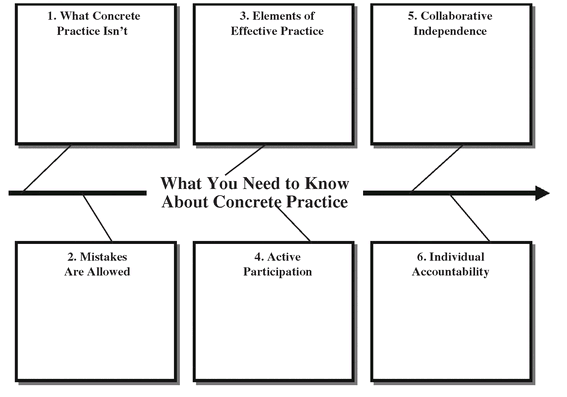
CONNECTIONS

One-Minute Connection: Fast Pass
Practice takes many forms. Rate the following items B for Best Practice and W for Worst Practice strategies:
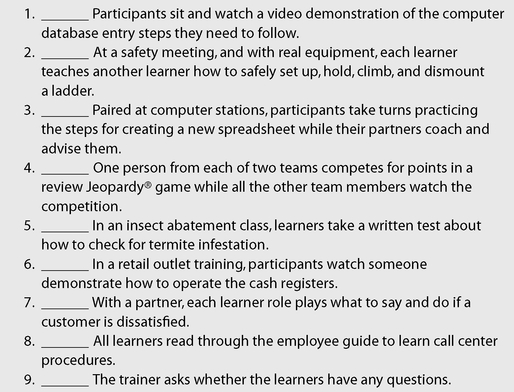
Check your answers against the ones below:
1. Worst. Participants sit and watch a video demonstration of the computer database entry steps they need to follow. What is needed is hands-on practice with real computers.
2. Best. At a safety meeting, and with real equipment, each learner teaches another learner how to safely set up, hold, climb, and dismount a ladder. This is skills-based practice at its best.
3. Best. Paired at computer stations, participants take turns practicing the steps for creating a new spreadsheet while their partners coach and advise them. This is another example of concrete, skills-based practice.
4. Worst. One person from each of two teams competes for points in a review Jeopardy® game while all the other team members watch the competition. Only two people are doing the active review here.
5. Worst. In an insect abatement class, learners take a written test about how to check for termite infestation. A written test checks knowledge comprehension; a skills-based demonstration by the learners is still needed.
6. Worst. In a retail outlet training, participants watch someone demonstrate how to operate the cash registers. Good for a start, but learners still need to do it themselves.
7. Best. With a partner, each learner role plays what to say and do if a customer is dissatisfied. This is practical and experiential.
8. Worst. All learners read through the employee guide to learn call center procedures. Reading isn’t practice.
9. Worst. The trainer asks whether the learners have any questions. Neither is a question/answer session.
In this part of the book, you will discover what is and isn’t concrete practice and the elements of effective practice.This part also includes fifteen concrete practice strategies that strengthen learners’ retention of skills and knowledge.
Imagine That . . .
The training is over. Participants have left the room. You are sitting down for the first time all morning, feet up, and reflecting on what everyone accomplished. Thinking back over the three hours, you realize that the best part of the entire learning experience was the hour during which learners participated in practice activities that gave them opportunities to apply what they had learned.
You had posted a list of activities on the wall, and you directed each table group to pick one activity that sounded interesting to them. On the list were activity titles such as Table Teach Back, Rounds and Repetition, Grab and Gab, Ball Toss, Table Demonstrations, Circle Teach Back, Cooperative Jeopardy, and Group Scavenger Hunt. You then gave each small group the printed instructions for the practice activity chosen by that group. Depending on the activity, some groups practiced the skills with their group members. Others created a whole-group review activity that everyone participated in. The hour was filled with active practice and review, conversation, collaborative work, laughter, and learning.
As participants left the room, you heard many comments about how much they learned and what a good time they had. “A very effective and satisfying hour of concrete practice,” you conclude, as you stand and close up the training room.

CONCEPTS
Practice, by definition, means doing something. Obviously, concrete practice is exactly that: learners repeatedly performing a skill until they become competent doing it. If there are no skills to be learned, then concrete practice refers to the active review of information learned. Either way, all learners are actively involved during the practice time, not just a few.
What Concrete Practice Is Not
Because concrete practice is the training segment that is often the most challenging, it helps to know what effective concrete practice is not. Effective concrete practice is not 
• Watching the trainer demonstrate the skill.
• Reading about or watching a video of people performing the skill.
• One or two learners competing in a review game while all others watch.
• Being part of a competitive team in which only the team leader participates in the competition.

• Review activities or games that are not topic-related.
• A paper/pencil test, although that may be one component of the practice.
• A question-and-answer session before the training ends.
• Performing a skill in a high-risk situation, where mistakes can lead to serious consequences.
In addition, there is sometimes a blurry line between concrete practice and a concept review. If there are no real-life, behavior-based skills to practice, then the concrete practice step actually becomes an activity-based concept review. This, in turn, leads to knowledge-based competency rather than skills-based competency. Sometimes knowledge-based competency is the goal of training.
Mistakes Are Allowed
Think about some of the physical skills you have and the amount of practice it took for you to learn how to perform them well. Driving a car, playing a musical instrument, cooking a gourmet meal, or playing sports all come to mind. The mistakes you made along the way were an important part of the learning. And while you learned, it was also important that you were encouraged; competition was kept to a minimum until you could demonstrate confidence and competency in performing the skill.
Concrete practice is about approximation, meaning that making mistakes (and learning how to correct them) is part of the practice. So perfection isn’t a goal of concrete practice; skill-building or knowledge-building toward a certain level of competency is.
Knowledge-building also requires concrete practice in a collaborative, low-risk learning environment, until learners can demonstrate knowledge-based competency. Some work-related examples of knowledge-based competency are: using a computer program, dealing effectively with customers, working a call-center hotline, filling out forms, interpreting data, making sales calls, creating employee schedules, managing staff, communicating with co-workers, building a team, solving problems, and so on. We could call these either cognitive or interpersonal skills, to differentiate them from physical skills such as operating equipment, following safety procedures, performing an inspection, or constructing a building, to name a few.
Whether practicing skills or acquiring new knowledge, mistakes are an integral, and sometimes necessary, part of concrete practice. I emphasize this because many trainers still assume that once learners hear information or see a skill demonstrated, they will be able to use it or do it correctly the first time around. When approximation is accepted as an important part of effective concrete practice, learners move toward competency more quickly.
Try This
Learner-Created Practice. Instead of setting up a practice activity and telling learners how to do it, invite them to create the activity. Give them a few minutes to come up with one practice strategy that they can do in their small groups or with the whole group. Or ask volunteers to create a practice activity for the whole group.The guidelines are that the activity must include everyone, it must reinforce skills or knowledge, and it must take place within a time limit that you set.
Elements of Effective Practice
Here are three important concrete practice elements that will increase either skills-based or knowledge-based competency:
• Active participation by all learners. Each learner needs to have multiple opportunities to demonstrate the skill or to participate in the active review.
• Collaborative interdependence among learners. When learners work cooperatively together to learn a skill, more learning takes place than if learners compete with each other.
• Individual accountability. Learners need to know what it is that they are expected to do or know—and how they will determine their own level of competency.
Let’s take a closer look at each of these three important elements.
Active Participation
As I mentioned earlier, one of the most common mistakes trainers make when they create practice activities is to assume that, if a few learners demonstrate a skill while everyone else watches, then everyone is learning. Instead, all learners need to participate in the concrete practice, even if they take turns while doing so.
Active participation doesn’t have to have to take place all at once. Skills-based practice can be divided into smaller practice segments following each of the concept segments. This way, learners practice one small part of a multi-step procedure at a time. For example, in a safety training on the Heimlich maneuver for choking victims, learners pair up and do each procedural step as the trainer explains it. Then they practice doing all the steps until they can demonstrate the procedure correctly.
If a training is knowledge-based, then learners can participate in an active review of what was learned, using a game, presentation, Teach-Back, and the like. The more physically active the review game is, the better. For example, in a customer service training, table groups create skits using real-life customer service issues they’ve encountered and demonstrate appropriate ways of handling these issues.
Collaborative Interdependence
Current brain research emphasizes the importance of collaboration in learning. When a learning community works together in positive ways to help its members learn, and when it provides support and encouragement among its members, learning increases. According to Jay Cross, “We humans exist in networks. We are part of social networks. Our heads contain neural networks. Learning consists of making and maintaining better connections to our networks” (2007, p. 7).
In contrast, competition “focuses on [learners] increasing their own achievement and on preventing [other learners] from achieving higher than they do” (Barkely, Cross, & Major, 2005, p. 17). This is not to say that competition is a bad thing. The research simply points out that, for many people, learning increases when the emphasis is on collaboration and not on competition. Competition seems to sharpen skills already learned, but only for those personality types who feed on the adrenalin rush competition provides. Many learners shut down when competition kicks in. The trick is not to avoid competition, but instead to de-emphasize it, make it more collaborative, or include it as a small part of the entire practice period.
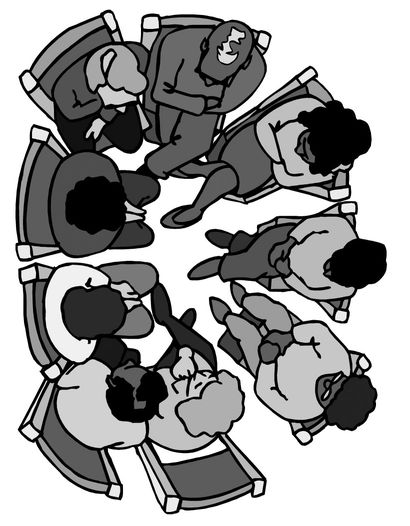
Individual Accountability
Learners need to be clear about what it is they are expected to do or to know, as well as how they will determine their own level of competency. If they have had opportunities at the beginning of the training to become familiar with the learning outcomes and to discuss and write their own learning goals, individual accountability is easier. The learning outcomes and personal goals will help learners stay focused on what they will be held accountable for. Dave Meier reminds us that “Unless what is learned is applied, there is no learning” (2000, p. 101). So concrete practice needs to be tied to the learning outcomes of the training. A practice activity or game unrelated to the learning outcomes is a waste of valuable learning time.

Make a List
Quickly now: Without looking back, list the three elements of effective concrete practice. Write them down, then look back in the chapter to check your answers.
1.
2.
3.
CONCRETE PRACTICE
For concrete practice with your own training programs, choose one or more of the fifteen activities from this part of the book. Some are short, quick practice activities that you can insert into your training right after each concept segment. Others combine all the information and/or skills taught into longer practice sessions. Use them in ways that work for you and your learners.
The activities are divided into three sections. Here are the section and activity titles and brief summaries:
• Five Teach-Back Strategies: Paired Teach-Back, Table Teach-Back, One-Legged Teach-Back, Improv Teach-Back, Circle Teach-Back. With these collaborative strategies, learners teach, coach, encourage, and give each other positive feedback and suggestions.
• Five Skills-Based Activities: In-Room Mentoring, Each Teach, Rounds and Repetition, Table Demonstrations, Skills-Based Game Shows. While on-the-job training (where a learner is apprenticed to an experienced professional) is the best way of learning and practicing a skill, the activities in this section will give you ways to include this kind of mentoring in a classroom setting.
• Five Learner-Created Games: Card Games, Grab and Gab, Cooperative Jeopardy, Ball Toss, Group Scavenger Hunts. Although competition is usually a major game element, the games in this section lessen the emphasis on competition and strengthen the emphasis on collaboration.

Change It
Now that you know the elements of effective practice, how would you turn the following Worst Practices into Best Practices? After each statement, write a sentence that describes the changes you would make. Then check your answers against mine.

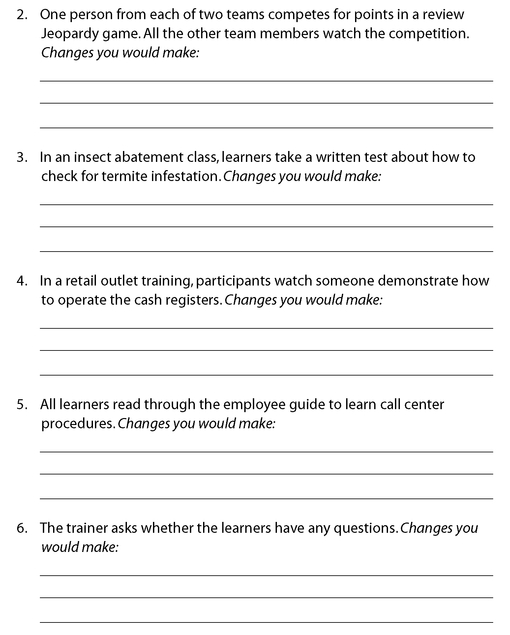
Here are my answers.Your answers might differ, but they should include one or more of the three elements of effective practice, as described in this chapter.
1. After watching the video, participants pair up at computers and mentor each other as they practice the database entry steps.
2. Each team’s members collaborate to come up with the team’s answers. The team leader position rotates so each person has the opportunity to speak for his or her team.
3. After finishing the written test, learners take turns describing how to check for termite infestation. They also physically demonstrate how to use the pest abatement equipment.
4. After watching the demonstration, learners take turns operating the cash register and mentoring each other.
5. Learners teach each other the call center procedures and then practice the procedures while coaching each other.
6. Each table group creates a set of test questions on index cards. Groups exchange sets and write or state answers to the card questions they received.
CONCLUSIONS
In order for concrete practice to be effective for all learners, the strategies you use must include active participation, collaborative interdependence, and individual accountability. Concrete practice is the “proof of the pudding,” if you will—the observable evidence that learners are moving toward skills-based or knowledge-based competency.
You don’t learn to swim, or play the piano,
by reading a book about it.
by reading a book about it.
Patricia Wolfe
Brain Matters, 2001, p. 101
Brain Matters, 2001, p. 101
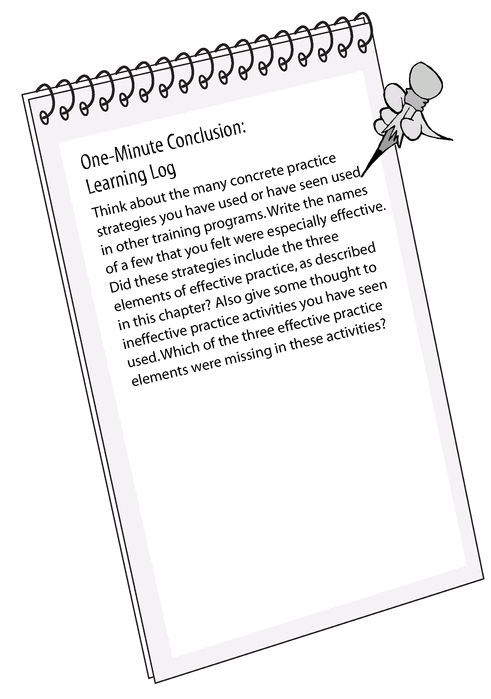
Trainer’s Toolbox
Write down the useful ideas from this chapter and flag this page.
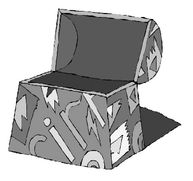
..................Content has been hidden....................
You can't read the all page of ebook, please click here login for view all page.
